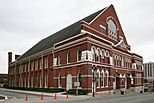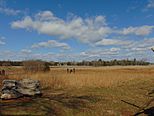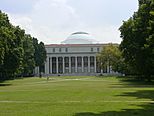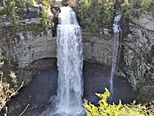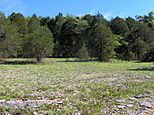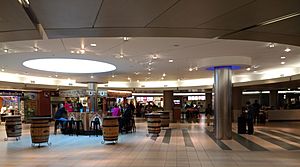Middle Tennessee facts for kids
Quick facts for kids
Middle Tennessee
|
|
|---|---|
|
Grand Division
|
|
|
Images, from top down, left to right: Skyline of Nashville, the Tennessee State Capitol, the Ryman Auditorium, Stones River National Battlefield in Murfreesboro, Vanderbilt University, Fall Creek Falls, Cedars of Lebanon State Park
|
|
| Nickname(s):
Middle TN, Middle Tenn.
|
|

The counties of Tennessee highlighted in red that are designated part of Middle Tennessee.
|
|
| Country | |
| State | |
| Largest city | Nashville |
| Area | |
| • Land | 44,054.2 km2 (17,009.41 sq mi) |
| Population
(2020)
|
2,883,086 |
| • Density | 65.44/km2 (169.50/sq mi) |
| Demonym(s) | Middle Tennessean |
Middle Tennessee is a big part of the state of Tennessee in the United States. It's one of the three main areas, called "Grand Divisions," that make up the state. This central region includes 41 of Tennessee's 95 counties.
Middle Tennessee is home to Nashville, which is the state's capital and largest city. You'll also find Clarksville here, the fifth-largest city, and Murfreesboro, the sixth-largest city and a big suburb of Nashville. The Nashville area is the most populated part of Tennessee. Middle Tennessee is the largest and most populated of the state's three Grand Divisions.
Geographically, Middle Tennessee has a unique landscape. It's surrounded by an area called the Highland Rim, which wraps around a bowl-shaped area known as the Nashville Basin. The Cumberland Plateau is also found in the eastern part of this region. Culturally, Middle Tennessee is part of the "Upland South," a term for a specific cultural area in the southern U.S.
Long ago, during the time before the American Civil War, settlers grew crops like cotton and tobacco here. They often used the forced labor of enslaved African Americans to work on their farms. Farmers also raised and trained animals, especially horses. The famous Tennessee Walking Horse breed was first developed in this region during that time.
Middle Tennessee was very important during the American Civil War. Federal troops occupied Tennessee from 1862 until the war ended. Many battles happened here as Confederate soldiers tried to control the major rivers. A Confederate general named Nathan Bedford Forrest led many attacks in this area. He destroyed Union property during the 1864 Battle of Johnsonville.
In the 1900s, the Grand Ole Opry started in Nashville. This helped make Nashville famous as the home of country music. Since the early 1970s, the region has changed a lot. Many new types of businesses have come to the area. These include car making, healthcare, banking, technology, and tourism. Both the Nashville and Clarksville areas are growing very quickly.
Contents
What Drives Middle Tennessee's Economy?
Middle Tennessee's economy is strong and growing fast. Many different industries help it thrive. These include music, car manufacturing, healthcare, and technology. The region's economy is one of the fastest-growing in the United States.
Music and Entertainment in Music City
Nashville is known as "Music City" because it's a huge center for country music. Many big and small record labels have offices in Nashville, especially in an area called Music Row. Today, Nashville is the second-largest place for music recording, right after New York City. The music business in Nashville brings in about $10 billion each year. It also provides around 56,000 jobs in the Nashville area.
Major Businesses and Technology Growth
The biggest service industry in Middle Tennessee is healthcare. More than 300 healthcare companies are based in the Nashville area. These include Hospital Corporation of America (HCA), which is the world's largest private hospital operator. Other important companies include Community Health Systems and Envision Healthcare.
Other key business areas are banking, finance, insurance, and publishing. The technology industry is also growing fast. Big tech companies like Amazon and Oracle have invested here. They plan to create thousands of jobs. Other major companies based in Middle Tennessee include Caterpillar Inc. in Nashville and Dollar General in Goodlettsville.
Car Manufacturing and Other Industries
Making cars is the biggest manufacturing industry in Middle Tennessee. Nissan has a large car assembly plant in Smyrna. It's the biggest car assembly plant in North America. Nissan also has an engine plant in Decherd. General Motors has a plant in Spring Hill. Nissan moved its North American main office to Franklin in 2005. Mitsubishi Motors did the same in 2019. Bridgestone has its North American headquarters in Nashville. It also has factories around the region. Many companies that make car parts are also located here. Other products made in Middle Tennessee include processed foods, electronics, and firearms.
Farming and Horse Breeding
Farmers in Middle Tennessee grow soybeans and tobacco. They also raise beef cattle throughout the region. Middle Tennessee is especially known for its plants and for breeding horses. Warren County is a top producer of nursery plants in the country. It's even called the "Nursery Capitol of the World." The soil in the Nashville Basin is great for growing grass that horses love. This makes the region a top place for horse riding and breeding. The Tennessee Walking Horse breed was first developed here in the late 1700s. It's now one of the most famous horse breeds in the world. The Cumberland Plateau also has a lot of trees. It's a major source of hardwood timber.
Energy Sources for the Region
The Tennessee Valley Authority (TVA) provides electricity to Middle Tennessee. TVA runs power plants that use coal and gas, like the Cumberland Fossil Plant. They also operate several dams that create hydroelectric power. TVA also buys power from dams on the Cumberland River. These dams are run by the United States Army Corps of Engineers. The biggest source of power for the region is the Browns Ferry Nuclear Plant in northern Alabama. It is the second-largest nuclear plant in the United States.
Fun Places to Visit: Tourism in Middle Tennessee
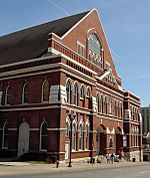
Tourism is a big part of Middle Tennessee's economy. Nashville has the most tourism in the state. It has many attractions, especially those related to its music history. Some popular places to visit include the Grand Ole Opry and the Country Music Hall of Fame and Museum. You can also visit the Ryman Auditorium and the Johnny Cash Museum.
There are also old homes preserved in the region. These include The Hermitage, which was the home of President Andrew Jackson. The National Park Service protects two Civil War battlefields here. These are Fort Donelson National Battlefield near Dover and Stones River National Battlefield in Murfreesboro. The Natchez Trace Parkway starts in Nashville. It runs through the southwestern part of Middle Tennessee. The state also has many state parks that protect historical sites and natural areas.
People and Population in Middle Tennessee
Middle Tennessee is the largest and most populated of Tennessee's three Grand Divisions. In 2020, it had 2,883,086 people living in its 41 counties. This was a big increase of over 427,000 people since 2010. Its population makes up about 41.72 percent of the state's total. It is the second most crowded Grand Division, after East Tennessee.
Main Cities and Metro Areas
Nashville, the state's capital and largest city, is in the middle of Middle Tennessee. It has almost 700,000 residents. The Nashville area, which includes 13 counties, has about 2 million people. It has been Tennessee's largest metropolitan area since the early 1990s.
Clarksville is Middle Tennessee's second-largest city. It has about 170,000 people. It is located in the northwest part of the region, near Kentucky. Murfreesboro is about 35 miles (56 km) southeast of Nashville. It is Middle Tennessee's third-largest city, with more than 150,000 residents. It is also the largest suburb of Nashville.
Other important suburbs of Nashville include Franklin, Hendersonville, and Smyrna. Spring Hill, Gallatin, and Mount Juliet are also key cities.
Besides Nashville and Clarksville, Cookeville in the eastern part of the region is an important city. Shelbyville, about 50 miles (80 km) southeast of Nashville, is another important population center. Other cities include Manchester, McMinnville, and Tullahoma.
|
Largest cities or towns in Middle Tennessee
Source: |
||
|---|---|---|
| Rank | Pop. | |
| 1 | Nashville | 689,447 |
| 2 | Clarksville | 166,722 |
| 3 | Murfreesboro | 152,769 |
| 4 | Franklin | 83,454 |
| 5 | Hendersonville | 61,753 |
| 6 | Smyrna | 53,070 |
| 7 | Spring Hill | 50,005 |
| 8 | Brentwood | 45,373 |
| 9 | Gallatin | 44,431 |
| 10 | Columbia | 41,690 |
Learning and Education Opportunities
Middle Tennessee has many colleges and universities. Some of the most well-known are Vanderbilt, Belmont, Lipscomb, and Tennessee State in Nashville. Tennessee Tech University is in Cookeville.
Other important universities include Austin Peay State University in Clarksville. The University of the South is in Sewanee. Cumberland University is in Lebanon. Middle Tennessee State University in Murfreesboro is the state's second-largest university.
Getting Around: Transportation in Middle Tennessee
Roads and Highways
Interstate 40 (I-40) goes through Middle Tennessee from east to west. It passes through Nashville and its eastern suburbs. Interstate 65 (I-65) runs north to south. It serves Nashville and its northern and southern suburbs like Brentwood and Franklin.
Interstate 24 (I-24) enters the region in Clarksville. It goes southeast to northwest, passing through Nashville and its southeastern suburbs. I-440 is a bypass around downtown Nashville. I-840 is an outer bypass around Nashville. Other important roads include State Route 155 (Briley Parkway) and SR 386 (Vietnam Veterans Boulevard).
Air, Rail, and Water Travel
Nashville International Airport (BNA) is the main airport for the region. It is the busiest airport in Tennessee. The Music City Star is a train service for people who travel to work. It serves Nashville and its eastern suburbs like Mt. Juliet and Lebanon.
CSX Transportation operates most of the freight train tracks in Middle Tennessee. They have a large train yard in Nashville called Radnor Yard. Both the Cumberland and Tennessee rivers can be used by boats in Middle Tennessee.
Images for kids
-
Postcard with an illustration of the reconstruciton of Fort Nashborough
-
The Battle of Franklin, November 30, 1864




